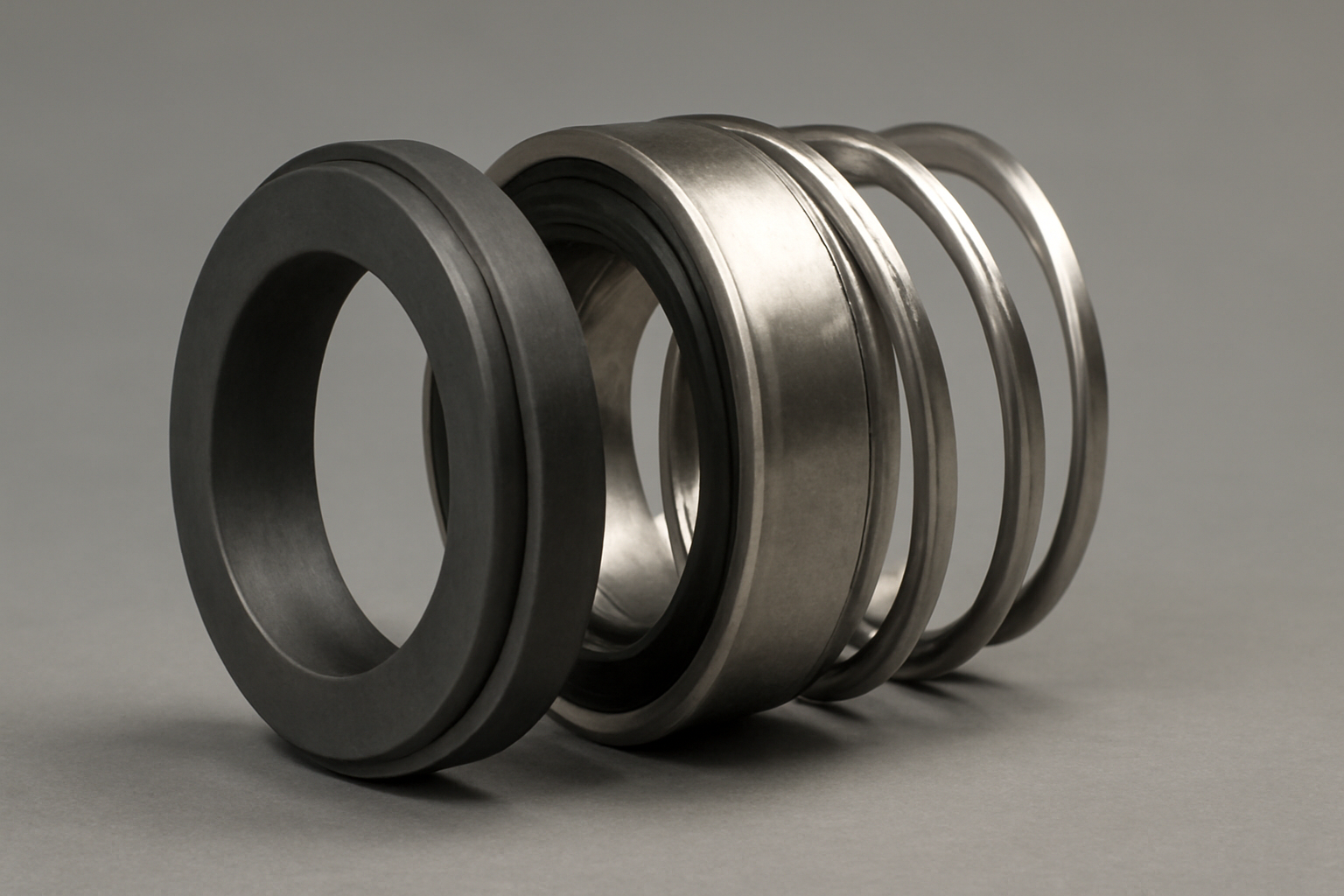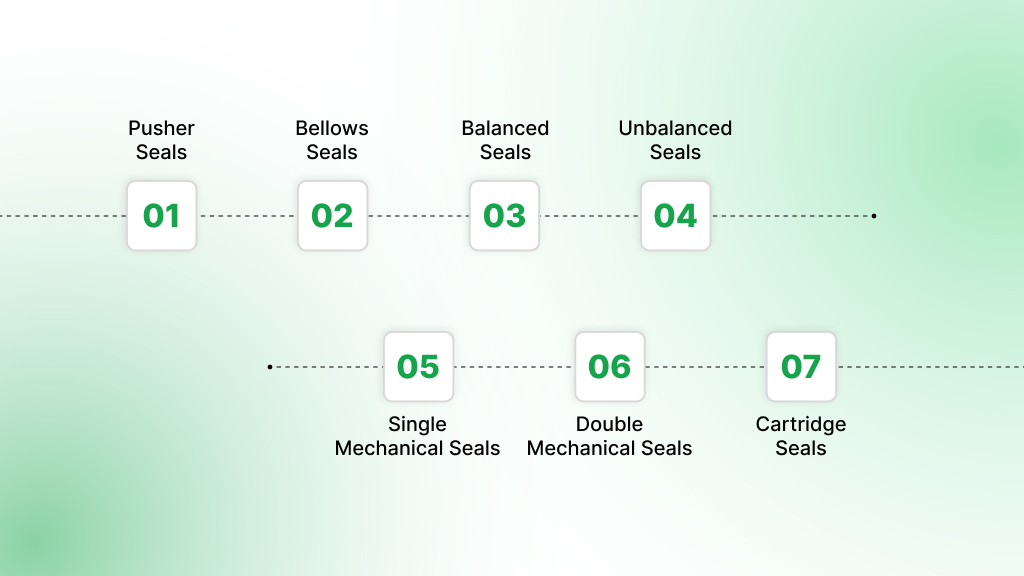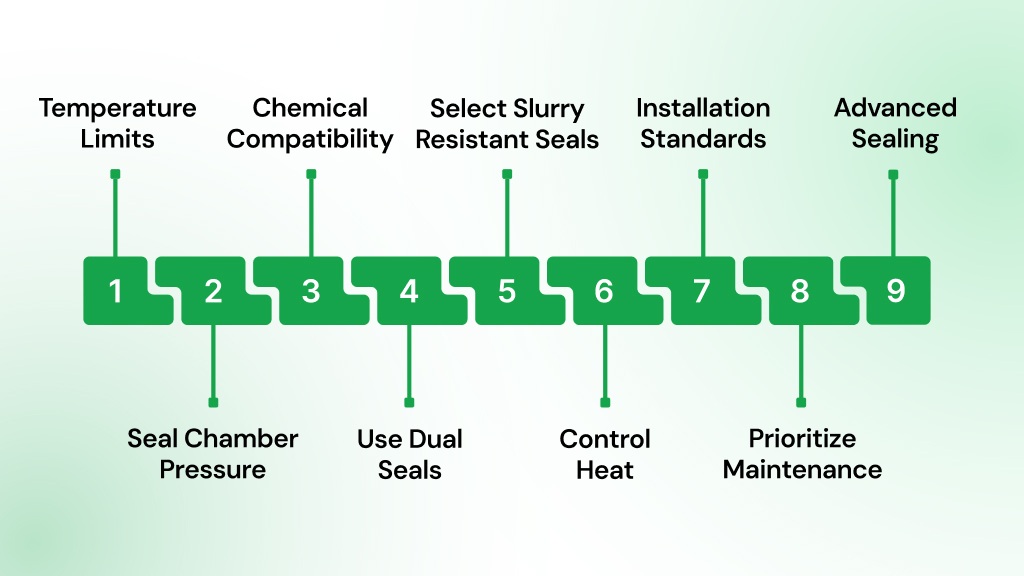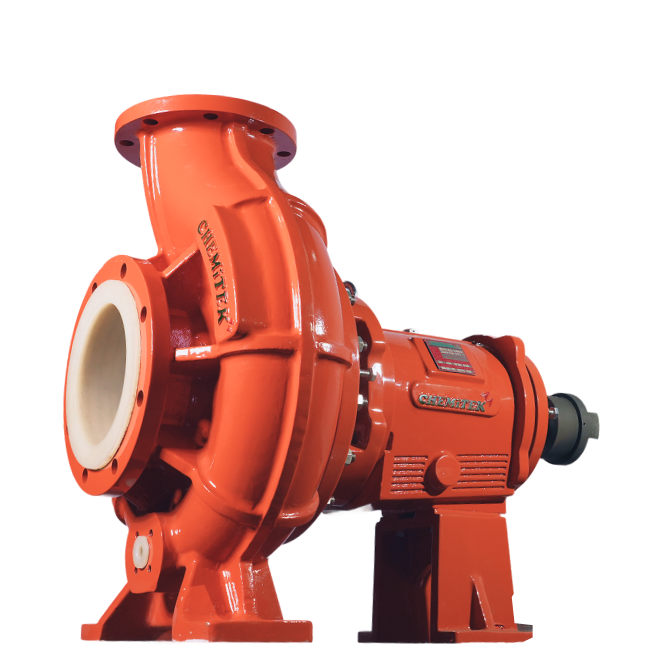Mechanical seal failures account for 85% of centrifugal pump breakdowns, costing facilities an average of $50,000 per incident in production loss, emergency repair, and downtime. In industries like chemical processing, power, and food manufacturing, a single unplanned outage can lead to daily losses exceeding $100,000.
The centrifugal pump mechanical seal acts as the first line of defense between the process fluid and the external environment. It plays a direct role in maintaining pump reliability, controlling emissions, and reducing overall maintenance costs. Poor seal selection leads to leakage, compliance risks, and reduced equipment life.
Choosing the right seal design and material is essential for handling pressure, temperature, and corrosive or abrasive fluids. The right decision improves uptime, lowers total cost of ownership, and protects both production goals and environmental safety.
Key Takeaways:
- A centrifugal pump mechanical seal prevents fluid from leaking where the shaft passes through the pump casing.
- It helps maintain safe, efficient operation while reducing wear and minimizing maintenance needs.
- Seal types include single, double, balanced, unbalanced, bellows, and cartridge. Each fits specific pressure, temperature, and fluid conditions.
- Selecting the right seal depends on fluid type, operating temperature, pressure range, and shaft speed.
- The centrifugal pump mechanical seal is widely used in industries such as chemicals, oil and gas, water treatment, and food processing for reliable and leak-free fluid transfer.
To understand the importance of selecting the right seal, it's helpful to first look at what a mechanical seal actually does within the pump system.
What is a Mechanical Seal in a Centrifugal Pump?

A centrifugal pump mechanical seal is installed at the point where the pump shaft passes through the casing. It creates a seal between the rotating shaft and the stationary pump housing.
Unlike traditional packing, which wears out quickly and leaks under pressure, a mechanical seal uses two precision surfaces pressed together by a spring system, supported by O-rings or elastomers.
This mechanism reduces friction and allows the pump to operate efficiently, even under aggressive process conditions.
Once you understand what a centrifugal pump mechanical seal does, the next step is knowing why your choice matters across different industrial settings.
Why Choosing the Right Mechanical Seal Matters: Key Benefits
The mechanical seal is the first line of defense against leaks. For high-stakes industries handling hazardous or high-value fluids, seal reliability is non-negotiable.
Benefits of the right seal include:
- Process containment and safety: Preventing leaks avoids contamination, ensures compliance, and maintains safety in regulated environments.
- Lower maintenance costs: Proper sealing reduces wear on shafts and bearings, leading to fewer breakdowns and service interruptions.
- Performance in challenging conditions: From slurries to acids and high temperatures, the right seal type is designed to perform under specific process parameters.
- Extended equipment life: High-quality sealing reduces internal damage, protects components, and improves long-term operational ROI.
With the benefits in mind, it becomes clear that mechanical seals are not just accessories, they’re critical components in maintaining pump performance across industries.
Key Role of Mechanical Seals in Industrial Pumping Systems
In industrial operations, mechanical seals are vital for equipment uptime. Around 60% of unplanned centrifugal process pump failures are seal-related, making mechanical seals a critical component in ensuring equipment reliability.
A correctly specified seal supports continuous, leak-free operation in chemical transfer pumps, wastewater treatment pumps, and high-temperature process pumps.
Here’s what mechanical seals deliver in demanding fluid handling conditions:
- Leak Containment: Maintains a tight seal in systems handling corrosive or toxic media like acid handling or pharma fluid pumps, reducing loss, contamination, and emissions.
- Wear and Shaft Protection: Prevents scoring and shaft damage in horizontal or corrosion-resistant pumps, extending service life and reducing unplanned downtime.
- Operational Efficiency: Preserves hydraulic balance and internal pressure in energy-efficient chemical pumps, improving flow consistency and lowering energy use.
- Process Safety: Crucial for handling volatile fluids in chemical, water treatment, and oil & gas pumps, preventing hazardous exposure and ensuring compliance.
To choose the right centrifugal pump mechanical seal, it’s important to first understand the different seal types available and how each one fits specific industrial needs.
Types of Centrifugal Pump Mechanical Seals

Mechanical seals are critical components in centrifugal pumps, ensuring leak-free operation and long-term reliability. In industries like chemical processing, oil and gas, pharmaceuticals, and wastewater treatment, mechanical seals prevent fluid leakage, withstand extreme conditions, and reduce equipment wear.
Each seal type is selected based on application-specific requirements including fluid characteristics, pressure, temperature, and maintenance preferences.
1. Pusher Seals
These seals rely on a spring-loaded secondary sealing element (like an O-ring) that moves axially with the shaft. This axial motion helps maintain consistent seal face contact despite minor shaft misalignment or wear.
Specifications:
Industry & Use
- Industries: Water treatment, HVAC systems, utility process pumps
- Use Case: Standard-duty pumping of clean or lightly contaminated fluids at moderate pressures and temperatures
Advantages:
- Tolerates minor shaft misalignments and deflections due to flexible O-ring movement
- Easily sourced and maintained, reducing lead times and downtime during replacement
- Ideal for general-purpose pumps operating in non-corrosive and non-abrasive conditions
Limitations:
- Continuous axial movement can lead to shaft sleeve scoring over time, especially in long-running applications
- Elastomer-based secondary seal may swell or degrade when exposed to aggressive chemicals
- Not recommended for slurries or crystallizing fluids, which can hinder spring operation and cause premature seal face wear.
2. Non-Pusher (Bellows) Seals
These seals eliminate sliding elastomers and use metal or elastomeric bellows that flex under axial shaft movement. They create a static secondary seal, avoiding shaft wear while tolerating high temperatures and chemical exposure.
Specifications
Industry & Use
- Industries: Chemical manufacturing, acid transfer lines, oil & gas refineries
- Use Case: High-temperature, corrosive fluid applications where shaft protection and zero contact wear are essential
Advantages:
- Compatible with a wide range of corrosive chemicals due to the use of exotic alloys and chemically inert elastomers
- Performs reliably under thermal shock and pressure fluctuations, especially in batch processing systems
Limitations:
- Bellows can fatigue or crack under cyclic loading if not properly selected for application pressure cycles
- Requires precise installation; misalignment or poor shaft finish can reduce performance and longevity
3. Balanced Seals
Balanced seals are designed to reduce the hydraulic forces acting on the seal faces by modifying the geometry. This helps lower friction and heat generation during operation, making them ideal for high-pressure or low-lubricity fluid applications.
Specifications
Industry & Use
- Industries: Refineries, petrochemical units, power plants
- Use Case: Handling light hydrocarbons, volatile solvents, and thermal oils under high-pressure conditions
Advantages:
- Lower axial face loading reduces seal face wear and heat generation, increasing seal longevity
- Suitable for fluids with low lubricity such as LPG, ammonia, and other volatile media
Limitations:
- Requires precise pressure balancing calculations; incorrect sizing may cause instability
- More complex assembly and repair due to additional balancing grooves and back faces
4. Unbalanced Seals
Unbalanced seals have their entire hydraulic load acting on the seal faces. While simple and economical, they’re best suited for low-pressure, non-critical applications.
Specifications
Industry & Use
- Industries: Agricultural pumps, utility cooling systems, general-purpose water circulation
- Use Case: Pumping clean or lightly contaminated water or low-viscosity process fluids
Advantages:
- Simple construction makes it easy to maintain, rebuild, and install even in small facilities
- Compatible with most standard pump shafts and housings, avoiding retrofitting
Limitations:
- Increased face wear under pressure due to full hydraulic force acting on faces
- Higher risk of heat buildup and leakage in volatile or vaporizing fluids
5. Single Mechanical Seals
Single seals feature one sealing interface exposed to the process fluid on one side and the atmosphere on the other. These are the most common mechanical seal designs used for non-hazardous, clean fluid systems.
Specifications
Industry & Use
- Industries: Building services, water supply networks, food-grade oil circulation
- Use Case: Low-risk fluid systems with no requirement for emission control or hazardous fluid containment
Advantages:
- Simple design makes training and installation easier in the field
- Can be upgraded to cartridge or balanced configuration without major equipment change
Limitations:
- May allow visible leakage or vapor escape, making it unsuitable for toxic, volatile, or environmentally sensitive media.
- Faces are exposed to process fluid directly, increasing wear risk in abrasive or scaling fluids
6. Double Mechanical Seals
Double seals consist of two sets of sealing faces: one set against the process fluid and the other against a barrier fluid. They offer enhanced containment and performance in difficult or hazardous applications.
Specifications
Industry & Use
- Industries: Pharmaceuticals, pesticide manufacturing, pulp and paper, food-grade processes
- Use Case: Applications requiring leak prevention of toxic, flammable, or abrasive media
Advantages:
- Excellent containment of hazardous or aggressive fluids, meeting environmental and safety standards
- Can handle abrasive slurries when combined with clean barrier fluid and external flush systems
Limitations:
- Higher initial and operating cost due to need for barrier fluid system and monitoring instruments
- Complex installation and maintenance, as it requires skilled technicians and space for ancillary systems.
7. Cartridge Seals
Cartridge seals are fully assembled sealing units that include the seal faces, sleeve, gland, and hardware in one compact system. These are designed to eliminate installation errors and reduce seal setting time, making them ideal for critical applications.
Specifications
Industry & Use
- Industries: Refineries, chemical plants, and process industries requiring minimal equipment downtime
- Use Case: Equipment requiring fast, precise seal replacement with minimal manual adjustment
Advantages:
- Reduces the risk of seal failure due to improper fitting or human error
- Ideal for standardizing sealing across multiple pump models or locations
Limitations:
- Larger overall size may not fit compact or legacy pump designs
- Requires careful handling during storage and installation due to pre-set configuration
8. Other Seal Types
While standard mechanical seals cover most industrial needs, there are additional sealing options that support specific operational requirements. These alternatives play a supporting or specialized role based on factors like cost, compatibility, and ease of maintenance.
Here's a look at commonly used alternative seal types and where they fit in:
Knowing the seal types alone does not ensure performance. For pumps that match your process, ensure durability and efficiency from the start. Trust Chemitek for the right solution.
How Do You Choose the Right Mechanical Seal for Industry?

The performance of a pump system often depends on the seal you choose. Selecting a mechanical seal is not just about standard specifications. It should be based on how the system operates under actual process conditions. Factors like temperature, pressure, fluid type, and maintenance access should guide your decision.
Here’s a practical breakdown to help you select the right seal that delivers performance, reliability, and safety.
Define Your Temperature Limits
- Use standard elastomers (like EPDM/NBR) for water-based processes up to 180°C
- Choose PTFE or perfluoroelastomers for chemical processes between 180°C–260°C
- For extreme temperatures or steam service, go with metal bellows seals that handle thermal cycling
Assess Seal Chamber Pressure, Not Pump Discharge
- Use balanced seals for high-pressure applications to reduce face loading
- For variable axial movement, select multi-spring or wave spring configurations
Match Materials to Chemical Compatibility
- Choose silicon carbide or tungsten carbide for seal faces when handling aggressive chemicals
- Opt for FFKM or PTFE O-rings for better chemical and temperature resistance
Use Dual Seals for Hazardous or Corrosive Fluids
- Apply double mechanical seals with barrier fluids to contain leaks and protect the environment
- Select corrosion-resistant metals like Hastelloy or Inconel for seal hardware
Select Slurry-Resistant Seals for Abrasive Media
- Use hard face combinations (tungsten carbide vs. silicon carbide) to prevent premature wear
- Integrate external flush systems to keep solids away from the seal face
Control Heat in High-Temperature Operations
- Choose metal bellows seals for thermal expansion tolerance
- Install cooling systems (2–5 GPM barrier fluid circulation) to manage seal face temperature
Follow Precision-Based Installation Standards
- Keep shaft runout under 0.05 mm to avoid uneven face loading
- Ensure seal housing bore concentricity is within 0.1 mm to prevent O-ring damage
Prioritize Condition-Based Maintenance
- Use leak detectors, vibration sensors, and temperature probes to track seal health
- Plan seal replacements during routine shutdowns to reduce emergency downtime costs
Adopt Advanced Sealing Technologies When Needed
- Choose dry gas seals for clean, zero-emission sealing in VOC-sensitive systems
- Use magnetic drive couplings to eliminate shaft seals altogether for toxic fluids
- Select split seals for large pumps to allow fast replacement without full disassembly
Once you’ve selected the right seal, it’s equally important to pair it with a pump designed for consistent, long-term performance. That’s where Chemitek comes in.
Chemitek: Reliable Pumping Solutions for Industries
Chemitek Process Equipment Pvt. Ltd., founded in 2009, is a leading manufacturer and supplier of custom-engineered centrifugal pumps designed for demanding industrial environments.
With deep expertise in application engineering, Chemitek offers metallic and non-metallic centrifugal pumps built to support safe, energy-efficient, and low-maintenance operation across sectors such as chemicals, pharmaceuticals, oil and gas, water treatment, and fertilizers.
- Reliable Sealing Support: Chemitek’s pumps are designed for compatibility with single, double, cartridge, and metal bellows seals, ensuring leak-free operation under various process conditions.
- Corrosion-Resistant Materials: Pump components are constructed using materials like SS316, SS316L, Hastelloy, Alloy 20, and more, providing strong resistance to chemical attack and thermal cycling.
- ANSI-Compliant Construction: All centrifugal pumps follow ANSI/ASME B73.1 design standards and support API Plan 53/54 sealing systems, making them suitable for handling aggressive and hazardous media.
- Energy-Efficient Operation: Precision casting and hydraulic balancing help reduce energy consumption, improve flow control, and minimize internal wear.
- Application-Specific Configurations: Chemitek pumps can be customized to meet specific flow rates, pressures, and fluid characteristics, delivering consistent performance in both standard and critical applications.
Conclusion
Choosing the right centrifugal pump mechanical seal type is essential for maintaining pump reliability, safety, and long-term efficiency. From unbalanced seals to double cartridge options, each serves specific process requirements based on fluid type, pressure, and maintenance needs.
In systems that depend on steady pump performance, a well-matched seal reduces downtime, prevents leaks, and supports smooth operation.
Selecting the ideal mechanical seal helps you improve reliability, reduce maintenance, and achieve long-term efficiency. Chemitek offers customized, high-performance centrifugal pumps designed to meet your specific process needs.
Talk to us today to learn how we can help optimize your operations and reduce costs with reliable, energy-efficient pumping solutions.
Frequently Asked Questions
1. How often should mechanical seals be replaced in industrial centrifugal pumps?
A: Replacement frequency depends on operating conditions and seal type. Single seals typically require replacement every 6-18 months, while double seals can operate 18-36 months between services. Condition monitoring extends intervals by detecting degradation before failure.
2. What causes premature mechanical seal failure in centrifugal pumps?
A: Installation errors account for 60% of premature failures, followed by improper material selection and inadequate maintenance. Shaft misalignment, incorrect seal chamber preparation, and contaminated barrier fluids create conditions leading to rapid seal degradation.
3. Can mechanical seals handle slurry applications with high solids content?
A: Yes, properly selected seals handle slurries up to 30% solid content. Hard face materials like tungsten carbide resist abrasive wear while external flush systems remove particles from seal chambers. Seal life depends on particle size, hardness, and concentration.
4. What is the difference between balanced and unbalanced mechanical seals?
A: Balanced seals distribute hydraulic forces to reduce face contact pressure, enabling operation at higher pressures with longer service life. Unbalanced seals concentrate full system pressure on sealing faces, limiting applications to lower pressures with shorter replacement intervals.
5. When should double mechanical seals be specified instead of single seals?
A: Double seals are required for hazardous fluids where single seal failure creates safety or environmental risks. They also provide extended service life in highly corrosive or abrasive applications where single seals fail frequently due to aggressive process conditions.

Latest posts
Ready to Upgrade Your Process Operations?
